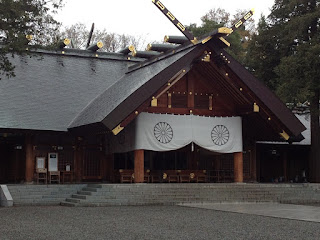Day 1 of our vacation ~ It wasn't our intention to travel to Hokkaido to see Sakuras. The Sakuras were expected to bloom in early May. However, by a stroke of luck, the Sakura season was delayed. As a result, the Sakuras were in full bloom during late-May when we were in Hokkaido. Sakura flowers could be found blooming from trees along the streets, in backyards and in the midst of forests on top of the hills.
In the Edo period, Sakura trees are often grown near Forts in Japan. The rationale behind this is that when the Sakura flowers bloom, they are viewed as a symbolism of regeneration and ephemerality of life. Hence, they become a huge morale booster which brings encouragement and motivation to the soldiers living in the Forts during wartimes.
Noticed that Hakodate's Fort Goryokaku is shaped like a 5-sided star pentagon? The clever design of the Fort gave soldiers situated at any one of the five pentacles a better view of enemies approaching from its neighbouring pentacles. This is unlike the usual 4-sided square Forts whereby soldiers standing guard on one-side of the Fort is unable to see and defend against enemies coming from the other three sides of the Fort.
Lastly, did you know, the Sakura is
NOT Japan's national flower! They blossom once a year for only 5-6 days and hence their short life span and quick death makes them unsuitable as a national flower. The national flower of Japan is the Chrysanthemum which is the emblem found on every Japanese's passport and even in temples, such as the Hokkaido Shrine which we visited on the 4th day of our vacation.








No comments:
Post a Comment